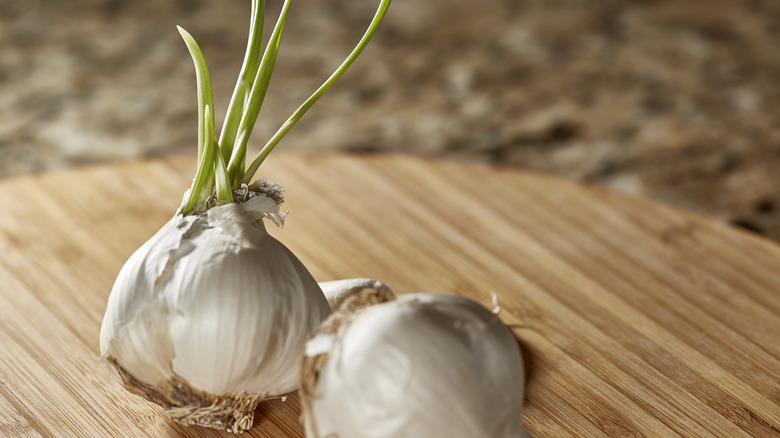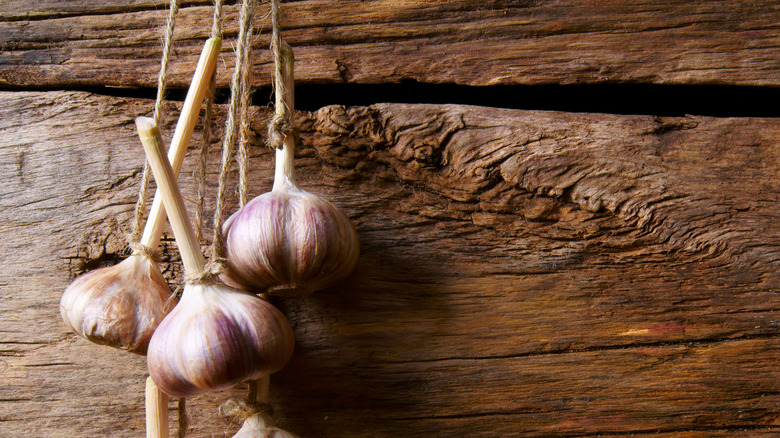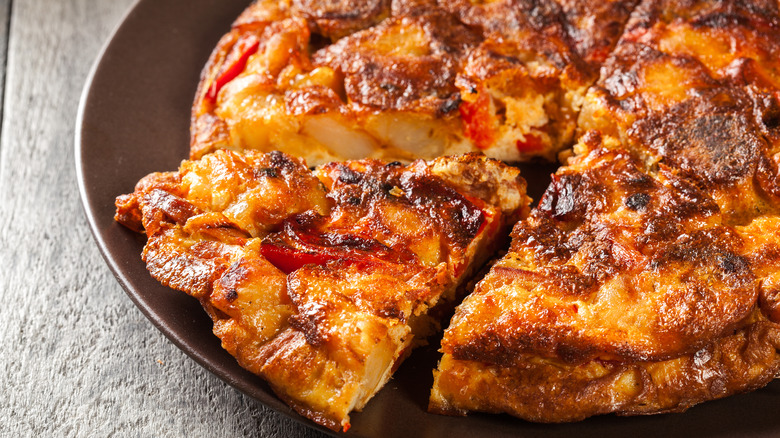Where To Store Garlic To Prevent Sprouting
One day you might come home from work and decide to make garlic bread for dinner. You grab a few garlic cloves and remove the peel, but you notice some green sprouts popping out. Luckily, sprouted garlic is perfectly safe to eat. However, those green shoots can have a bitter flavor.
Sprouted garlic is actually more nutritious than its fresh counterpart, reports a 2014 study published in the Journal of Agricultural and Food Chemistry. As the researchers note, sprouting can increase the antioxidant activity of garlic and boost its potential health benefits. Plus, you can use the sprouted cloves in most dishes, except for those where garlic is one of the primary ingredients.
Those little green sprouts usually pop out of old garlic cloves. They're not a sign of spoilage but an indicator that your garlic is about to go bad and should be consumed as soon as possible. The best thing you can do is prevent them in the first place.
Try these hacks to keep your garlic from sprouting
Fresh garlic can last for up to 12 months, but its moisture content decreases over time. Generally, it begins to sprout when it's past its prime. So, if you notice those little green shoots, check the garlic to make sure it hasn't gone bad. Discard any cloves with soft or dark spots, mold, missing pieces, or a foul odor. As a rule of thumb, use the garlic no later than 10 days after you see the sprouts popping out.
Also, there are a couple of things you can do to keep your garlic fresh for longer and prevent sprouting. One option is to freeze it. If you go this route, you can either freeze the whole bulb or separate the cloves beforehand. Alternatively, puree the garlic with a little bit of olive oil, divide the paste into portions, and freeze them in plastic bags. Or you can simply chop the garlic, arrange it in a single layer, and freeze the whole thing.
Sprouting usually occurs faster in cold temperatures. Therefore, it's not recommended to refrigerate fresh garlic. Your best bet is to store it in a cool, dry place, such as a cabinet or drawer. First, place it in a ceramic container or bowl to ensure good airflow. Another option is to mince the garlic and preserve it in olive oil or vinegar. For example, pickled garlic can be a delicious addition to mashed potatoes, stuffed olives, and salad dressings.
How to cook with sprouted garlic
Garlic sprouts can be slightly bitter, but this doesn't mean you should discard them. Professional chef David Lebovitz performed an experiment to see how the sprouts compared to fresh garlic. First, he prepared a batch of mayonnaise with finely chopped garlic and one with green sprouts. The latter proved to be too spicy for his taste. Next, he cooked two small batches of pasta — one with fresh garlic and one with sprouted garlic. "The two pastas tasted almost the same; the browned garlic didn't taste different in either version," said Lebovitz.
Need one more reason to use sprouted garlic in your recipes? According to Prevention, sprouted plants are rich in phytoalexins, a class of compounds with antibacterial and antifungal properties. "Most of these are toxic to microorganisms and insects but beneficial to human health," explained Jong-Sang Kim, an associate professor at the University of Iowa.
Sprouted garlic works best in cooked dishes, but you can eat it raw, too. Use it in omelets, frittatas, spaghetti sauce, sautéed spinach, or meatballs, just to name a few. You might also want to try these delicious recipes that call for garlic, veggies, and other simple ingredients. However, sprouted garlic has quite a strong flavor and can overpower other ingredients, so it may not be ideal for mayo, gazpacho, aioli, and other raw recipes.


